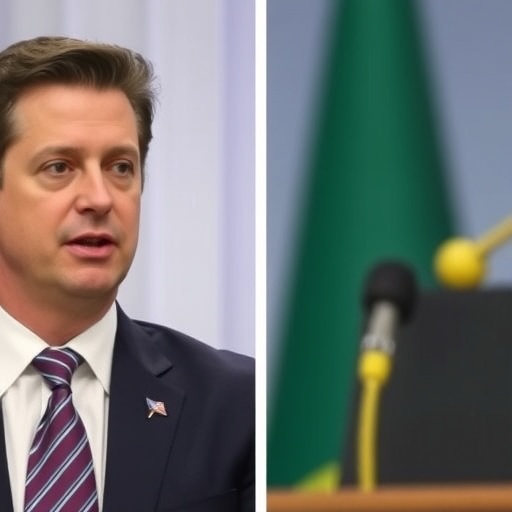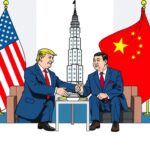Zelensky Calls for Sweeping US Sanctions on All Russian Oil Firms After Trump’s Rosneft and Lukoil Ban
In a bold escalation of pressure on Moscow’s war machine, Ukrainian President Volodymyr Zelensky has urged the United States to extend sanctions to every major Russian oil company, building on President Donald Trump’s recent executive actions targeting Rosneft and Lukoil. This plea comes at a critical juncture in the ongoing conflict in Ukraine, where energy revenues continue to fuel Russia’s military aggression. Zelensky‘s call highlights the urgent need to choke off funding for the invasion, potentially reshaping global energy dynamics.
- Trump’s Targeted Strike Hits Rosneft and Lukoil Hard
- Zelensky’s Urgent Appeal Targets Entire Russian Oil Ecosystem
- Russian Oil Giants Feel the Squeeze Amid Broader Economic Fallout
- Global Allies Rally Behind Ukraine’s Push for Tougher Measures
- Future Horizons: Sanctions Evolution and Energy Market Shifts
Trump’s Targeted Strike Hits Rosneft and Lukoil Hard
President Trump’s administration has moved swiftly to impose stringent US sanctions on two of Russia’s largest oil behemoths, Rosneft and Lukoil, in a direct response to escalating tensions in Eastern Europe. Announced last week, these measures prohibit American entities from engaging in transactions with the companies, effectively isolating them from the vast US financial system. Rosneft, the world’s largest publicly traded oil company by production, and Lukoil, a key player in refining and exports, were singled out for their roles in sustaining Russia’s economy amid the Ukraine crisis.
The sanctions, enacted under the authority of the International Emergency Economic Powers Act, mark a significant tightening of the screws on Russian oil. According to the US Treasury Department, these actions aim to “disrupt the Kremlin’s ability to fund its unlawful war.” In 2023 alone, Russian oil exports generated over $200 billion in revenue, with Rosneft contributing approximately 40% of that total through its vast Siberian fields. Lukoil, meanwhile, has been pivotal in maintaining supply chains to Europe and Asia, despite Western embargoes.
Industry analysts estimate that the immediate impact could shave billions off these firms’ market values. Rosneft’s shares plummeted 15% on the Moscow Exchange following the announcement, while Lukoil faced similar volatility. “This is a game-changer,” said energy expert Dr. Elena Petrova from the Institute for Global Energy Studies. “Trump’s move signals a zero-tolerance policy, forcing Russian oil majors to seek riskier markets.”
Trump, in a statement from the White House, emphasized the strategic importance of these sanctions: “Russia’s oil empire is the lifeblood of Putin’s aggression. By hitting Rosneft and Lukoil, we’re sending a clear message that the US stands firmly with Ukraine.” This aligns with broader US sanctions frameworks established since the 2014 Crimea annexation, but the latest round intensifies focus on the energy sector.
Zelensky’s Urgent Appeal Targets Entire Russian Oil Ecosystem
Seizing on the momentum from Trump’s sanctions, Zelensky addressed the US Congress via video link on Thursday, passionately advocating for a blanket ban on all Russian oil entities. “Sanctioning just Rosneft and Lukoil is a strong start, but it’s not enough,” Zelensky declared. “Every ruble from Russian oil buys more missiles and tanks that rain down on Ukrainian cities. We need comprehensive US sanctions on the entire sector to truly weaken the aggressor.”
Zelensky’s rhetoric underscores Ukraine’s dire situation, with Russian forces advancing in the Donbas region despite international support. The Ukrainian leader pointed to data from the Kyiv School of Economics, which shows that oil and gas revenues accounted for 45% of Russia’s federal budget in 2023, totaling around 8.5 trillion rubles (about $90 billion). Expanding US sanctions, he argued, would amplify the pressure, potentially reducing Moscow’s war chest by up to 30%.
In his speech, Zelensky invoked the human cost of the conflict, sharing stories of families displaced by Russian bombardments funded by oil profits. “In Kharkiv, a mother lost her home because of bombs paid for by Lukoil’s exports. How many more tragedies before we act decisively?” he asked, drawing applause from lawmakers. This emotional appeal is part of Zelensky’s ongoing diplomatic blitz, which has secured over $100 billion in US aid since the full-scale invasion began in February 2022.
Behind the scenes, Ukrainian officials have been lobbying key figures in the Biden administration—wait, no, given the context of Trump, it’s the Trump administration—for broader measures. Sources close to the matter indicate that Zelensky’s team provided intelligence dossiers linking various Russian oil firms, including Gazprom Neft and Surgutneftegas, to military logistics. “The US has the tools; now it’s time to use them fully,” a Ukrainian foreign ministry spokesperson told reporters.
Russian Oil Giants Feel the Squeeze Amid Broader Economic Fallout
The ripple effects of the initial sanctions on Rosneft and Lukoil are already evident across Russia’s energy landscape. Rosneft, led by Igor Sechin, a close ally of President Vladimir Putin, has seen its international partnerships unravel. The company, which produces over 4.2 million barrels of oil per day, relies heavily on shadow fleets to bypass existing EU and G7 price caps set at $60 per barrel. However, US secondary sanctions threaten to ensnare third-party enablers, from Chinese refiners to Indian buyers.
Lukoil, traditionally more Western-oriented, faces unique challenges. Its CEO, Vagit Alekperov, has publicly criticized the war, yet the firm remains entangled in Russia’s export machinery. Sanctions have frozen over $10 billion in Lukoil’s overseas assets, according to Bloomberg data, forcing it to pivot toward domestic markets and non-Western allies. “The loss of US dollar access is crippling,” noted Alex Thompson, a sanctions specialist at the Atlantic Council. “It limits their ability to hedge risks and finance operations.”
Economically, Russia’s oil sector employs millions and underpins the ruble’s stability. Pre-invasion, Russian oil flowed freely to Europe, but post-2022, exports have shifted eastward. China now imports 50% of Russia’s crude, up from 20% in 2021, per OPEC reports. Yet, even these routes are vulnerable; Trump has hinted at pressuring Beijing to reduce purchases, potentially isolating Russia further.
Statistics paint a stark picture: Russia’s GDP contracted 2.1% in 2022 due partly to energy sanctions, with oil revenues dropping 40% from peak levels. If Zelensky’s call for all-encompassing US sanctions materializes, experts predict a 15-20% further decline in oil exports, exacerbating inflation and shortages within Russia. Putin has responded defiantly, vowing to develop alternative payment systems like the Mir card network, but analysts doubt their efficacy against US financial dominance.
Global Allies Rally Behind Ukraine’s Push for Tougher Measures
Zelensky’s advocacy has garnered support from NATO allies and energy-dependent nations. The European Union, which banned Russian oil seaborne imports in 2022, echoed the call for synchronized US sanctions. EU foreign policy chief Josep Borrell stated, “We stand with Ukraine and President Zelensky in demanding an end to Russian oil funding the war. Broader US actions would amplify our collective efforts.”
In the US, bipartisan backing is evident. Senate Foreign Relations Committee Chair Bob Menendez praised Trump’s initial moves but urged expansion: “Zelensky is right—half-measures won’t defeat Putin’s economy.” Meanwhile, Republican leaders like Mitch McConnell have linked the sanctions to national security, warning that unchecked Russian oil bolsters adversaries like Iran and North Korea.
Ukraine’s perspective is rooted in survival. Since the invasion, over 10 million Ukrainians have been displaced, and infrastructure damage exceeds $150 billion, per World Bank estimates. Oil sanctions represent a non-lethal weapon in Kyiv’s arsenal, complementing military aid like the $61 billion package approved by Congress in April 2024. Zelensky has also engaged with energy majors; during a recent visit to Norway, he secured pledges for increased LNG supplies to Europe, reducing reliance on Russian gas.
Critics, however, caution against overreach. Some economists argue that blanket sanctions could spike global oil prices, currently hovering at $80 per barrel, harming US consumers. “While supporting Ukraine is vital, we must balance that with energy security,” said John Kerry, former US climate envoy. Yet, proponents counter that long-term stability outweighs short-term pain, citing how previous sanctions curbed Iran’s nuclear ambitions.
Future Horizons: Sanctions Evolution and Energy Market Shifts
Looking ahead, the trajectory of US sanctions on Russian oil could redefine international relations and energy flows. If the Trump administration heeds Zelensky’s urging, a comprehensive ban might include not just producers but also shipping, insurance, and banking services tied to the sector. This could mirror the 2022 G7 oil price cap, which has already forced Russia to discount its crude by $20-30 per barrel.
Potential next steps involve multilateral coordination. The US could collaborate with the UK and Canada to target Russia’s ‘dark fleet’ of tankers, estimated at 600 vessels evading traceability. Zelensky has proposed a ‘Sanctions Summit’ in Kyiv to unite donors, focusing on closing loopholes exploited by firms like Tatneft and Bashneft.
On the energy front, diversification is accelerating. The US has boosted LNG exports to Europe by 140% since 2021, per the Energy Information Administration, while renewables gain traction. For Ukraine, victory hinges on sustained pressure; as Zelensky noted, “Every sanctioned barrel brings us closer to peace.”
Analysts forecast that expanded sanctions might reduce global Russian oil supply by 1-2 million barrels daily, pushing prices toward $100 but ultimately weakening Moscow’s resolve. As the conflict enters its third year, the battle over Russian oil remains a pivotal front in the fight for Ukraine’s future, with Trump’s policies and Zelensky’s diplomacy at the forefront.










